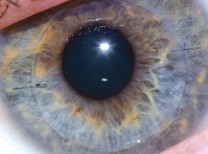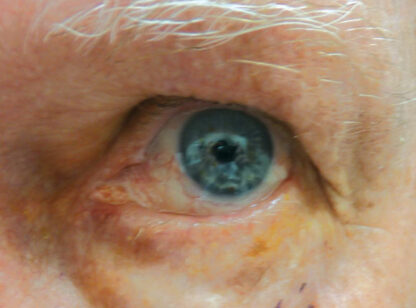Because our eyes serve many purposes beyond providing visual input, they can be important indicators of other health-related issues. A variety of systemic conditions have ocular manifestations. One overlooked organ that may cause significant changes to the eyes is the thyroid gland which functions as our inner “thermostat,” setting the rate at which our body uses energy. When it is underactive, a person may feel cold, experience fatigue and gain weight. When it is overactive, symptoms include feeling overheated, palpitations, anxiety/nervousness and unintended weight loss.

The eyes may also be affected when there is thyroid dysfunction, whether it be under- or over- active. A common hormone to check in lab work is TSH (thyroid stimulating hormone) which signals the thyroid’s activity level. If a person has an underactive thyroid, the TSH will be elevated – the body is mounting a significant positive “on” signal to rev up the thyroid. When the gland is overactive, the opposite occurs and the TSH will be lower than normal. There are times when the TSH value is in the normal range, but a person may be experiencing systemic and/or ocular symptoms.
The ocular symptoms include pain around the eyes, often described as a pressure sensation which may increase with eye movements. The eyelid may also swell and look “juicy.” This is often attributed to lack of sleep, excessive salt intake, weight gain, or the aging process, but it is actually an important indicator of thyroid dysfunction. As the disease progresses the eyes may become red and inflamed. Often there are complaints of burning, irritation and excessive tearing. Chemosis occurs when the conjunctiva (outer clear covering of the eye) becomes edematous with a jelly-like appearance on the surface. As the inflammation progresses, the tissues around the eye swell and displace the globe itself. The fatty tissues may expand as well as the muscles that control eye movement. As this occurs the body tries to compensate. The eyes often begin to bulge outwards, giving a surprised appearance (eyelid retraction). The body allows the eyes to project outwards (exophthalmos) so the edematous tissues do not squeeze the optic nerve (which connects the eye to the brain) excessively, thus causing vision loss. If the body is not able to compensate enough, then there is a risk of permanent vision loss from damage to the optic nerve; this condition is called compressive optic neuropathy.
Thyroid eye disease (TED) is an immune system mediated response. The thyroid serves as the antigen (perceived as foreign invaders), activating the immune system. As the immune system recognizes these antigens, the response causes a secondary response in the ocular region. As the inflammatory process persists, it may lead to formation of scar tissue, which may tighten the muscles that control eye movement. Patients may then experience strabismus, or misalignment of the eye. The eyelids may also become stiffer and more retracted, exposing more of the white of the eyes. These are all important symptoms which require treatment and therefore must not be overlooked.
Dr. Hui is the founder of The Eyelid Institute in Palm Desert. She is an oculoplastic surgeon with a special interest in helping patients with eyelid, lacrimal and orbital conditions and can be reached at (760) 610.2677.











































Comments (0)